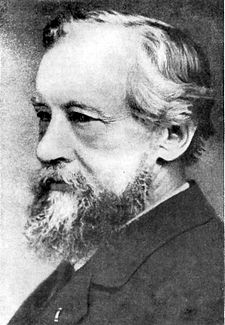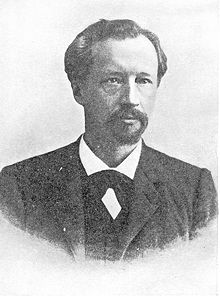- Hugo de Vries
-
Hugo de Vries 
Hugo de Vries, ca. 1907Born February 16, 1848 Died May 21, 1935 (aged 87)[1] Institutions Leiden University Hugo Marie de Vries ForMemRS[2] (Dutch pronunciation: [ˈhyxoː də ˈvriːs]) (February 16, 1848, Haarlem – May 21, 1935, Lunteren) was a Dutch botanist and one of the first geneticists. He is known chiefly for suggesting the concept of genes, rediscovering the laws of heredity in the 1890s while unaware of Gregor Mendel's work, for introducing the term "mutation", and for developing a mutation theory of evolution.
Contents
Early life
De Vries was born in 1848, the oldest son of Gerrit de Vries (1818–1900), a lawyer and deacon in the Mennonite congregation in Haarlem and later Prime Minister of the Netherlands from 1872 until 1874,[3] and Maria Everardina Reuvens (1823–1914), daughter of a professor in archaeology at Leiden University. His father became a member of the Dutch Council of State in 1862 and moved his family over to The Hague. From an early age Hugo showed much interest in botany, winning several prizes for his herbariums while attending gymnasium in Haarlem and The Hague.
In 1866 he enrolled at the Leiden University to major in botany. He enthusiastically took part in W.F.R. Suringar's classes and excursions, but was mostly drawn to the experimental botany outlined in Julius Sachs' 'Lehrbuch der Botanik' from 1868. He was also deeply impressed by Charles Darwin's evolution theory, despite Suringar's skepticism. He wrote a dissertation on the effect of heat on plant roots, including several statements by Darwin to provoke his professor, and graduated in 1870.
Early career
After a short period of teaching, De Vries left in September 1870 to take classes in chemistry and physics at the Heidelberg University and work in the laboratory of Wilhelm Hofmeister. In the second semester of that school year he joined the lab of the esteemed Julius Sachs in Würzburg to study plant growth. From September 1871 until 1875 he taught botany, zoology, and geology at schools in Amsterdam. During each vacation he returned to the lab in Heidelberg to continue his research.
In 1875 the Prussian Ministry of Agriculture offered De Vries a position as professor at the still to be constructed Landwirtschaftliche Hochschule ("Royal Agricultural College") in Berlin. In anticipation, he moved back to Würzburg, where he studied agricultural crops and collaborated with Sachs. By 1877, Berlin's College was still only a plan, and he briefly took up a position teaching at the University of Halle-Wittenberg. The same year he was offered a position as lecturer in plant physiology at the newly founded University of Amsterdam. He was made adjunct professor in 1878 and full professor on his birthday in 1881, partly to keep him from moving to the Berlin College, which finally opened that year. De Vries was also professor and director of Amsterdam's Botanical Institute and Garden from 1885 to 1918.
Definition of the gene
In 1889, De Vries published his book Intracellular Pangenesis,[4] in which, based on a modified version of Charles Darwin's theory of Pangenesis of 1868, he postulated that different characters have different hereditary carriers. He specifically postulated that inheritance of specific traits in organisms comes in particles. He called these units pangenes, a term 20 years later to be shortened to genes by Wilhelm Johannsen.
Rediscovery of genetics
To support his theory of pangenes, which was not widely noticed at the time, De Vries conducted a series of experiments hybridising varieties of multiple plant species in the 1890s. Unaware of Mendel's work, De Vries used the laws of dominance and recessiveness, segregation, and independent assortment to explain the 3:1 ratio of phenotypes in the second generation.[5] His observations also confirmed his hypothesis that inheritance of specific traits in organisms comes in particles.
He further speculated that genes could cross the species barrier, with the same gene being responsible for hairiness in two different species of flower. Although generally true in a sense (orthologous genes, inherited from a common ancestor of both species, tend to stay responsible for similar phenotypes), De Vries meant a physical cross between species. This actually also happens, though very rarely in higher organisms (see horizontal gene transfer).
In the late 1890s, De Vries became aware of Mendel's obscure paper of thirty years earlier and he altered some of his terminology to match. When he published the results of his experiments in the French journal Comtes Rendus de l'Académie des Sciences in 1900, he neglected to mention Mendel's work, but after criticism by Carl Correns he conceded Mendel's priority.
Correns and Erich von Tschermak now share credit for the rediscovery of Mendel’s laws. Correns was a student of Nägeli, a renowned botanist with whom Mendel corresponded about his work with peas but who failed to understand its significance, while, coincidentally, Tschermak's grandfather taught Mendel botany during his student days in Vienna.
Mutation theory
In his own time, De Vries was best known for his mutation theory. In 1886 he had discovered new forms among a display of the evening primrose (Oenothera lamarckiana) growing wild in a meadow. Taking seeds from these, he found that they produced many new varieties in his experimental gardens; he introduced the term mutations for these suddenly appearing variations. In his two-volume publication The Mutation Theory (1900–1903) he postulated that evolution, especially the origin of species, might occur more frequently with such large-scale changes than via Darwinian gradualism, basically suggesting a form of saltationism. De Vries's theory was one of the chief contenders for the explanation of how evolution worked, leading, for example, Thomas Hunt Morgan to study mutations in the fruit fly, until the modern evolutionary synthesis became the dominant model in the 1930s. Somewhat ironically, the large-scale primrose variations turned out to be the result of chromosomal duplications (polyploidy), while the term mutation now generally is restricted to discrete changes in the DNA sequence.
Finally, in a published lecture of 1903 (Befruchtung und Bastardierung, Veit, Leipzig), De Vries was also the first to suggest the occurrence of recombinations between homologous chromosomes, now known as chromosomal crossovers, within a year after chromosomes were implicated in Mendelian inheritance by Walter Sutton.[6]
Honors and retirement
In May 1905, De Vries was elected Foreign Member of the Royal Society. In 1910, he was elected a member of the Royal Swedish Academy of Sciences. He was awarded the Darwin Medal in 1906 and the Linnean Medal in 1929.
He retired in 1918 from the University of Amsterdam and withdrew to his estate "De Boeckhorst" in Lunteren where he had large experimental gardens. He continued his studies with new forms until his death in 1935.
Books
His best known works are:
- Intracellular Pangenesis (1889)
- The Mutation Theory German edition Bd. 1-2 (1901–03), English edition Volume 2 (1909–10) Retrieved 2009-08-20
- Species and Varieties: Their Origin by Mutation (1905)
- Plant Breeding (1907), German translation (1908)
References
- ^ Ralph E. Cleland (1936). "Hugo de Vries". Proceedings of the American Philosophical Society (American Philosophical Society) 76 (2): 248–250. JSTOR 984672.
- ^ Hall, A. D. (1935). "Hugo de Vries. 1848-1935". Obituary Notices of Fellows of the Royal Society 1 (4): 371. doi:10.1098/rsbm.1935.0002.
- ^ Nanne van der Zijpp, "De Vries." Mennonite Encyclopedia, Scottdale, PA: Herald Press, 1955-59: vol. IV, p. 862-863.
- ^ http://www.esp.org/books/devries/pangenesis/facsimile/
- ^ Stamhuis, I. H.; Meijer, O. G.; Zevenhuizen, E. J. (1999). "Hugo de Vries on heredity, 1889-1903. Statistics, Mendelian laws, pangenes, mutations". Isis; an international review devoted to the history of science and its cultural influences 90 (2): 238–267. PMID 10439561.
- ^ Crow, E. W.; Crow, J. F. (2002). "100 years ago: Walter Sutton and the chromosome theory of heredity". Genetics 160 (1): 1–4. PMC 1461948. PMID 11805039. http://www.pubmedcentral.nih.gov/articlerender.fcgi?tool=pmcentrez&artid=1461948.
- ^ "Author Query". International Plant Names Index. http://www.ipni.org/ipni/authorsearchpage.do.
Further reading
- Stamhuis, I. H. (2007). "Discovery of the correspondence of Hugo de Vries with his friend and colleague Jan Willem Moll". The Mendel newsletter; archival resources for the history of genetics & allied sciences (16): 7–12. PMID 19069204.
- Guignard, J. L. (2005). "About Hugo De Vries' letter written to Léon Guignard dated November 12, 1899, complimenting him for the discovery of double fertilization". Revue d'histoire de la pharmacie 53 (345): 85–93. PMID 16021760.
- Lenay, C. (2000). "Hugo De Vries: From the theory of intracellular pangenesis to the rediscovery of Mendel". Comptes rendus de l'Academie des sciences. Serie III, Sciences de la vie 323 (12): 1053–1060. PMID 11147091.
- Theunissen, B. (1994). "Knowledge is power: Hugo de Vries on science, heredity and social progress". British journal for the history of science 27 (94 Pt 3): 291–311. PMID 11639948.
- Theunissen, B. (1994). "Closing the door on Hugo de Vries' Mendelism". Annals of Science 51 (3): 225–248. doi:10.1080/00033799400200231. PMID 11639916.
- Theunissen, B. (1993). "Nature study and happiness in life: Hugo de Vries, Eli Heimans and Jac. P. Thijsse". Gewina 16 (4): 287–307. PMID 11630205.
- Bowler, P. J. (1978). "Hugo De Vries and Thomas Hunt Morgan: The mutation theory and the spirit of Darwinism". Annals of science 35 (1): 53–73. PMID 11615685.
- Darden, L. (1976). "Reasoning in scientific change: Charles Darwin, Hugo de Vries, and the discovery of segregation". Studies in history and philosophy of science 7 (2): 127–169. PMID 11615593.
- Van Der Pas, P. W. (1970). "The correspondence of Hugo de Vries and Charles Darwin". Janus; revue internationale de l'histoire des sciences, de la medecine, de la pharmacie, et de la technique 57: 173–213. PMID 11609703.
- "Hugo de Vries; commemoration". Revue medicale de Liege 5 (23): 816. 1950. PMID 14809033.
- Andrews, F. M. (1930). "Hugo De Vries". Plant physiology 5 (1): 174.172–180. PMC 440205. PMID 16652643. http://www.pubmedcentral.nih.gov/articlerender.fcgi?tool=pmcentrez&artid=440205.
- Vaughan, T. W. (1906). "The Work of Hugo De Vries and Its Importance in the Study of Problems of Evolution". Science 23 (592): 681–691. doi:10.1126/science.23.592.681. PMID 17754450.
External links
- Biography (in Dutch)
- Ridley, Matt, The Agile Gene, 2003, ISBN 0-06-000679-X, pp 231–2.
- History of Horticulture
- Works by Hugo de Vries at Project Gutenberg
- Works by Hugo de Vries available online at the Biodiversity Heritage Library.
- Biographical sketch of Hugo de Vries with a picture
- Article relating the work of Gregor Mendel
- Concerning the Law of Segregation of Hybrids
- Pangenes
Categories:- Botanists with author abbreviations
- 1848 births
- 1935 deaths
- Dutch botanists
- Dutch biologists
- Geneticists
- People from Haarlem
- Leiden University alumni
- University of Amsterdam faculty
- Foreign Members of the Royal Society
- Members of the Royal Swedish Academy of Sciences
Wikimedia Foundation. 2010.

